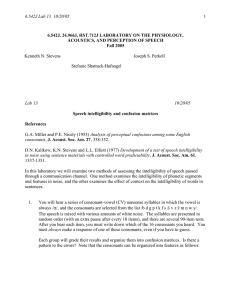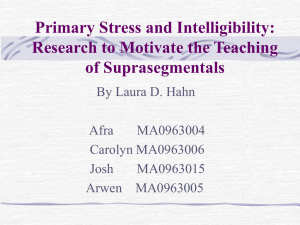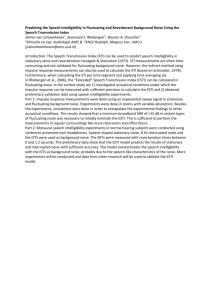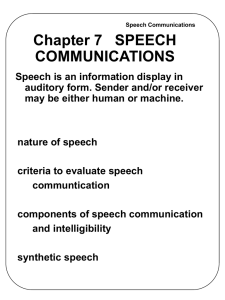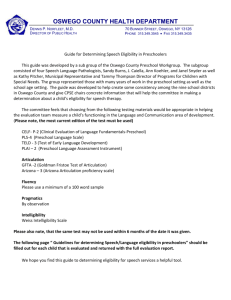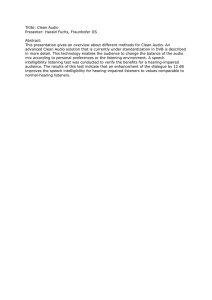Digital Project Working Group Interim Report May 2008
advertisement
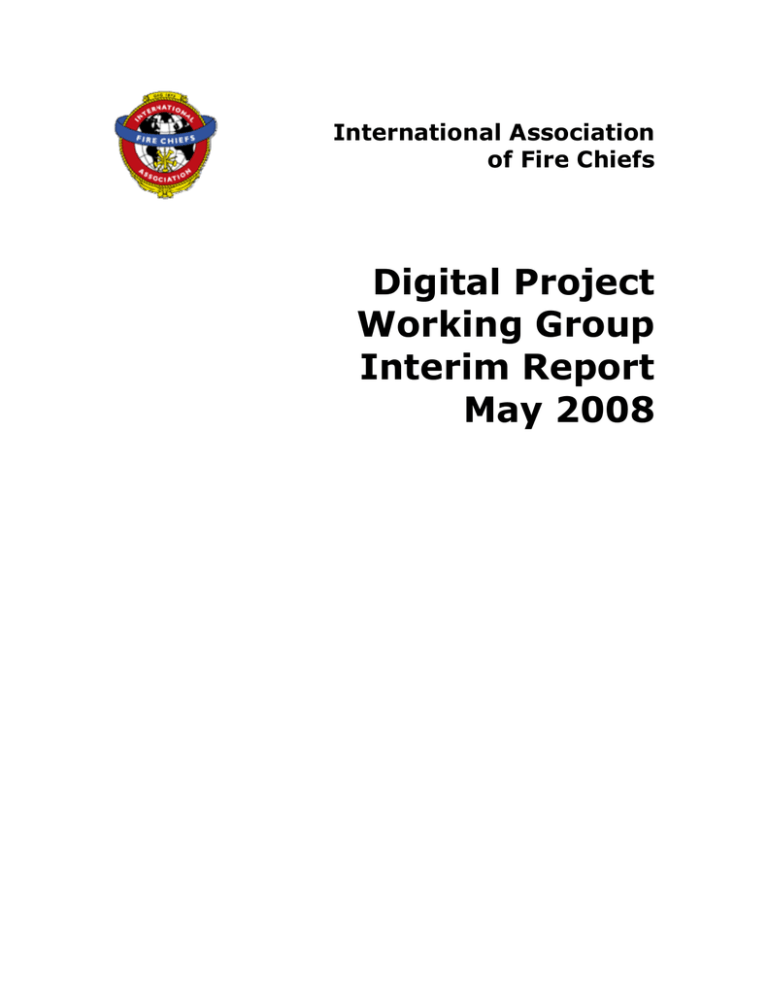
International Association of Fire Chiefs Digital Project Working Group Interim Report May 2008 International Association of Fire Chiefs Digital Project Working Group Interim Report and Recommendations: Fireground Noise and Digital Radio Transmissions Executive Summary In late 2006 and early 2007, the International Association of Fire Chiefs (IAFC) began to receive reports of possible communications problems involving digital two-way portable radios in close proximity to common fire ground noise. The IAFC established the Digital Project Working Group (formerly the Digital Problem Working Group), composed of the fire service, law enforcement, government and industry to collectively investigate the problem and provide data-driven recommendations. The intent of this report is to alert the fire service that noise on the fireground can interfere with intelligible radio communications and to provide an overview of the research data and both highlevel technical recommendations and practical model practices that can be utilized for short-term solutions in the field. It is not the intent of the Digital Project Working Group to make recommendations on an agency’s selection of a communications system or any firefighting equipment. Many factors will influence these decisions. The information in this report should be considered part of the overall decision-making process in addition to other factors. However, the Best Practices Task Group has developed procedures and technical issues directed at operating consideration for field users. The report includes conclusions based on nine months of laboratory testing conducted by the National Institute of Standards and Technology (NIST) and the National Telecommunications and Information Administration (NTIA). The report includes recommendations for the fire service, the federal government and industry—many but not all surrounding the following major themes. • Standards and guidelines should be developed for scenario-based user training utilizing communications equipment. A broader review of standards and a gap analysis that addresses factors of communication systems, including but not limited to intelligibility, use practices, maintenance and alignment, should be performed. • The testing clearly identified intelligibility degradation while using either digital or analog communication systems in some high-ambient noise environments. However, analog technology provides for a statistically similar or better voice intelligibility quality than digital radios. • The fire service needs to be more engaged in federal processes of developing user requirements and standards, as well as industry development and testing. Additional research is needed to explore other standards support required for public-safety (including law enforcement, EMS, etc.) application of communications systems. This report is considered interim because the Digital Project Working Group and its task groups will remain intact to continue ongoing work. The Testing Task Group will engage in further testing to delineate the problem and investigate technical ways to mitigate the known issues. The Best Practices Task Group will focus on investigating the best practices and training available to mitigate the known issues. IAFC has published the best-practice presentation and other resources at www.iafc.org/digitalproblem. IAFC DPWG Report May 30, 2008 1 Introduction In late 2006 and early 2007, the International Association of Fire Chiefs began to receive reports of firefighters who were experiencing unintelligible audio communications while using a digital two-way portable radio in close proximity to the low-pressure alarm of their self-contained breathing apparatus (SCBA). Other common fireground noises, such as power tools, diesel engines and personal alert safety system (PASS) devices, appeared to affect voice intelligibility. The IAFC board of directors directed the Communications Committee to establish the Digital Project Working Group (formerly the Digital Problem Working Group) to investigate the problem. The intent of this report is to alert the fire service that noise on the fireground can interfere with intelligible radio communications. The report is organized into sections that provide background on the issue; the steps the Digital Project Working Group took to investigate the problem in an objective, laboratory setting; the results of the testing and corresponding analysis and recommendations; and best operational practices. This report is considered interim because the Digital Project Working Group and its task groups will remain intact to continue ongoing work. The Testing Task Group will engage in further testing to delineate the problem and investigate technical ways to mitigate the known issues. The Best Practices Task Group will focus on investigating the best practices and training available to mitigate the known issues. The IAFC has published the best practices presentation, available at www.iafc.org/digitalproblem. There are many significant factors that contribute to the challenges of present-day public-safety communications, and they include but aren’t limited to the increased number of radios operating at an emergency scene, radio complexity, inadequate radio training, unique traits of trunked radio systems, in-building coverage and audio intelligibility in high-noise environments. The Digital Project Working Group focused solely on the last issue. It is not the intent of the Digital Project Working Group to make recommendations on an agency’s selection of a communications system or any firefighting equipment. Many factors will influence these decisions. The information in this report should be considered part of the overall decision-making process in addition to other factors. Today, there is no audio intelligibility performance standard for public-safety radio communications systems. The National Fire Protection Association (NFPA) 1981 standard for SCBA performance was used for these laboratory experiments. Work needs to be done to establish an audio-intelligibility performance standard for all public-safety radio communications systems. Background Under an IAFC-developed protocol, the Digital Project Working Group initiated preliminary testing, which indicated there was indeed a problem. The IAFC alerted its members to this issue, asking them to contact the Digital Project Working Group if they had experienced similar issues. As research was gathered, the working group noted that while many fire departments were using digital radio systems with success, there may be interference to voice transmission in the presence of common fireground noise. Also noted was the fact that the problem is not specific to any one radio manufacturer; in fact, the issue is industry wide, inclusive of all the equipment on the fireground. In May 2007, the working group, led by Chief Charles Werner, Charlottesville (Va.) Fire Department, held its initial meeting in Fairfax County, Va. Representatives from the fire service, IAFC DPWG Report May 30, 2008 2 law enforcement, the Department of Commerce, DHS and industry participated in the meeting. Industry representation included radio equipment and SCBA/fire equipment manufacturers. In May 2008, the working group met at the National Institute of Standards & Technology/National Telecommunications & Information Administration laboratory in Boulder, Colo., to learn the results of the objective testing performed over the preceding nine months and to develop best practices and recommendations to protect firefighters in high-noise conditions. Best Practices and Testing Task Groups Identified As its first task, the Digital Project Working Group assigned two task groups to investigate the intelligibility problem and develop potential solutions. The Best Practices Task Group was charged with developing recommended practices that radio users can implement to minimize or eliminate the distortion problem. Some of the suggested practices are technical or procedural considerations that organizations should consider adopting to maximize user safety and efficiency. The task group strongly emphasizes the comprehensive and continuing training radio users must have to successfully use communications equipment, particularly in a high-noise environment. Radio systems that are designed and constructed without consideration of fire department requirements frequently do not meet the needs of fire and rescue users. Consequently, another important recommendation is that the fire service should be actively involved in the design and development of requirements for any communication system implementation from the beginning. The Testing Task Group was charged with conducting tests in a laboratory environment to objectively quantify the nature of the distortion problem and identify potential solutions and their effectiveness. During the year, the Testing Task Group collaborated with Institute for Telecommunications Sciences (ITS) engineers as they conducted the testing of communications systems. Following analysis of test results, both task groups strongly recommend that standards and guidelines should be developed for scenario-based user training utilizing their communications equipment. Currently no relevant standards exist. But beyond this issue, the task groups recommend that a broader review of standards and a gap analysis that addresses factors of communication systems including, but not limited to, intelligibility, use practices, maintenance, and alignment should be performed. There is currently no intelligibility performance standard for public safety radio communication systems. Evaluating Communication Systems: ITS Testing The test to evaluate the intelligibility of communication systems assessed three systems. Two vocoder technologies—the baseline Project 25 (P25) Full Rate vocoder and the P25 Enhanced Full Rate vocoder—were compared to 25 kHz analog FM under nine different noise conditions. In three of the background noise conditions, testers also evaluated 12.5 kHz analog FM to determine whether that might be a viable alternative to meet the FCC’s narrowbanding mandate while still providing a required level of intelligibility to the user. The communication systems were tested in the following conditions. • No mask, no background noise (baseline or clean condition) • No mask, fire-truck pump panel • Mask, with no background noise IAFC DPWG Report May 30, 2008 3 • Mask, two PASS alarms • In-mask low-air alarm • Mask, rotary saw cutting metal garage door • Mask, chainsaw cutting wood • Mask, 2½” hose with fog nozzle • Amplified mask, rotary saw cutting metal garage door ITS engineers, in collaboration with the Testing Subcommittee, decided upon a protocol known as the Modified Rhyme Test (MRT) to evaluate the behavior of digital and analog communication systems in the presence of fireground noise. In this type of test, each tester listens to a sentence asking the individual to select a word from a list. The intelligibility of a communication system can be difficult to quantify since it is a subjective issue, relying on an individual’s ability to discern words. The listeners’ ability to select the correct word is averaged across a panel of test listeners and produces a percentage of intelligibility score. The results of the NIST/NTIA testing can be found at www.its.bldrdoc.gov/pub/ntia-rpt/08-453. Note: Since there is no audio intelligibility standard for public-safety voice communications, the findings and comments referenced throughout this report are based on comparable scores of analog FM and vocoder technologies tested. Testing Task Group: Findings, Comments and Recommendations Findings The testing clearly identified intelligibility degradation while using either of the digital or analog communication systems in some high-ambient noise environments. The testing indicated there are significant radio communication challenges regarding SCBA and other fire-safety equipment. In the case of a mask with no additional background noise at the transmission site, there was a notable degradation in intelligibility for the digital systems. Some SCBA low-air alarm designs and PASS are of particular interest to the fire service as they have caused significant intelligibility degradation during testing. The performance of the 25 kHz analog system was either statistically similar to or better than the P25 digital systems for all environments. In testing of all the systems, five of the nine environments were too noisy for intelligible communication, with less than 20 percent intelligibility. In testing all of the systems, in four of the five environments, intelligibility was below 10 percent. The 12.5 kHz analog system was statistically similar to the 25 kHz analog system. Analog FM performed better than the digital P25 Full Rate and P25 Enhanced Full Rate systems in six of the nine environments tested under the MRT protocol. In one case, all radios performed at an equivalent level. In one case, the P25 Enhanced Full Rate performed better than P25 Full Rate and Analog FM, and in another instance the P25 Enhanced Full Rate performed at a level equivalent to the Analog FM. In the case of P25 Full Rate and P25 Enhanced Full Rate, the P25 Enhanced Full Rate system performed better than the P25 Full Rate in five of the nine environments. The two were IAFC DPWG Report May 30, 2008 4 equivalent in three environments, and the P25 Full Rate performed better than the P25 Enhanced Full Rate in one case. From a vocoder perspective, differences can be noted from the testing; however, additional testing is needed to determine if these differences are the result of the vocoder itself or variations in the subscriber units utilizing the different vocoders. Comments Based on the MRT test scores, analog communications was more intelligible in six of nine highnoise environments tested. In two of the nine tests, analog and digital were statistically similar. In one instance, enhanced vocoder was more intelligible than analog. The test results indicate that digital communication needs improvement, especially in high-noise environments. Fire service personnel routinely work in and cannot avoid high-noise environments, and this is a critical issue for firefighter safety. Any improvements that recognize and can improve the publicsafety working environment and increase communications intelligibility should be considered a high priority. This may include both reductions in noise emissions on the fireground as well as modifications to reduce the noise impact on the communication systems. Through this process, the task group recognized that testing was performed in a fire servicecentric manner and notes that other public-safety agencies—such as law enforcement, EMS, federal—using digital systems incorporating the vocoders tested may face similar challenges in their operating environments. The task group observed that there may be additional standards support required for public-safety application of communication systems. There is no intelligibility performance standard for public-safety radio communication systems. A broader review of standards and a gap analysis that addresses factors of communication systems, including but not limited to intelligibility, use practices, maintenance and alignment, should be performed. Included in this analysis may be incorporation of a radio-communication intelligibility test into a future revision of National Fire Protection Association (NFPA) 1981 or NFPA 1221, updates to the P25 Statement of Requirements, etc. Based on these findings, there is a concern about the 2013 FCC-mandate for agencies to move to 12.5 kHz channels. The fire service has had no significant participation in the process established to incorporate user requirements into the standards development. By beginning to participate in the user requirements process, the fire service can have a significant impact on future 12.5 kHz and 6.25 kHz standards. The fire service must be an active participant and provide feedback on these public-safety communications issues, including narrowbanding, P25, vocoder development and similar issues. Recommendations 1. The fire service community should participate on the P25 User Needs Committee to incorporate high-background noise and high-risk environment performance requirements that truly represent public-safety emergency operations. 2. Agencies should seek FCC approval to operate hybrid systems in 700 MHz voice bands to license at the system-wide level for select cases. This recommendation does not refer to low power or non-itinerant channels but to infrastructure. 3. Agencies should seek grant allowance/funding for ongoing efforts. 4. The IAFC should specifically request an allowance for dual mode analog/digital systems in grant guidance. 5. A mentoring program should be developed to train communication specialists within the ranks. IAFC DPWG Report May 30, 2008 5 6. The IAFC should discuss the timing of the 6.25 kHz equivalent efficiency with the FCC. 7. Fire service organizations should recommend standardization of all alarm sounds so that industry can better design communications equipment to be more resilient to the noise. 8. The IAFC should share this report with the law enforcement and other public-safety communities and seek their input and participation for future testing. 9. The IAFC should continue to support Best Practices and Testing Task Groups. 10. A national study should be conducted to fully understand how public safety uses radios and conduct a task analysis of the public safety operating environment for communications to identify other challenges that may exist. 11. Industry should develop additional technologies that do not burden the firefighter, that are integrated in the equipment, and that can be quickly implemented. 12. The breathing apparatus industry should design and manufacture future apparatus so that all low-air alarms, including mask-mounted alarms and PASS devices, don’t interfere with communications equipment. In addition, radio manufacturers should consider existing and proven firefighting equipment when designing radios to be used by the fire service and in their respective environments. Furthermore, the breathing-apparatus and fire-equipment industries and radio manufacturers should work collaboratively to identify existing conflicts between their respective products in order to develop strategies that will correct those conflicts and prevent future potential oversights. 13. Future testing should define an intelligibility comparison of the signal strength within a jurisdiction or coverage area (digital cliff 1 ) versus analog loss-of-signal. 14. Manufacturers should provide an indicator of impending loss of signal strength. 15. Further testing should be conducted to assess the impact on performance in high-noise environments of enhancements to the communications system. A possibility for future testing should investigate alternative testing methods such as the script recognition methods that industry uses, where users are tested on the ability to understand the entire message versus identifying one specific word. Best Practices Task Group: Recommendations The Best Practices Task Group has developed two sets of recommendations—procedures and technical issues directed at department leadership and operating considerations for field users. These best practices should be considered carefully by department leaders. Explanatory or supporting material is included following each recommendation. Fire Service Leadership 1. Train all personnel to properly use the assigned radio equipment in conjunction with all components of the protective ensemble. Comprehensive and continuing training is critical to the successful use of complex communications equipment. Communication equipment is an essential component of a firefighter’s overall safety ensemble and as such needs to be given appropriate consideration when designing training programs for new personnel and when providing training for existing staff. 1 “Digital cliff” describes the sudden loss of radio signal as the user moves beyond the coverage area. IAFC DPWG Report May 30, 2008 6 Presently, most agencies don’t incorporate this type of training. The lack of training increases the potential for communications failure at critical times and adversely affects firefighter safety. 2. Develop standards and guidelines for scenario-based user training utilizing their communication equipment. They must include integration of communication policies and procedures into agency operations. One of the review elements following any critical incident is communication effectiveness. The only way to achieve effectiveness throughout the fire service is by training on what constitutes effective communications during an incident. Currently no relevant standards exist. 3. Fire departments should be actively involved in the design and development of requirements for any communication-system implementation from the beginning. The importance of fire department participation in the development and installation of radio communication systems can’t be overstated. The participation of representatives of all current and potential end users (including fire service, law enforcement, EMS, public service) in the development of new communication systems is critical for success. Radio systems designed and constructed without consideration of fire department requirements frequently don’t meet the needs of fire and rescue users. 4. Incident commanders should evaluate background noise in the environment as a safety consideration in task assignments. Additional personnel may need to be assigned to a task to ensure communication capability when there are high levels of background noise in the environment. Traditionally, incident commanders may not consider background noise when evaluating safety concerns and the required resources to mitigate those concerns. Given that background noise can significantly degrade communication capabilities (regardless of the radio technology being used), consideration should be given to assigning additional staff to provide communications for personnel operating in high-noise environments. 5. System managers and users should work with their vendors to ensure that their radios and accessories are compatible and configured with the optimal system settings to maximize audio intelligibility in high-noise environments. Modern radios are very intricate devices with many configuration options. Some options can have a significant impact on a radio’s performance when operating in high-noise areas. Each radio manufacturer should work with users to ensure the configuration in use maximizes the radio’s performance when operating in a high-noise environment. Additionally, radio programmers should ensure radios are configured so that only the microphone being used is keyed when the radio is transmitting. 6. When practical, consider the use of accessories, such as speaker microphones, throat microphones and in-ear microphones to reduce the impact of background noise. Radio accessories can dramatically reduce the impact of background noise on audio intelligibility. Special attention must be paid when selecting radio accessories to ensure they are compatible with the environment they are to be used in. Many accessories may not be compatible with the structural firefighting environment; agencies should carefully evaluate the specific accessories for the operational environment where they will be used. IAFC DPWG Report May 30, 2008 7 7. Consider communication-equipment integration requirements in the design of SCBA and PASS equipment and other equipment and systems that contribute to the firefighter’s protective envelope. Communication equipment is an essential component of a firefighter’s overall safety ensemble and as such needs to be given appropriate consideration when procuring and integrating equipment for the firefighter’s protection and safety. Field User 1. When practical, use the radio for the initial distress call before manually activating the PASS in a mayday situation. PASS devices create a great deal of background noise very close to the radio microphone so transmitting on the radio before activating a PASS optimizes the probability that a voice message can be transmitted successfully. Providing a clear radio report imparts more information than activating the PASS device and maximizes the probability of a successful resolution to the problem. The recommended sequence is to first transmit a voice message and second to activate the PASS. 2. Ensure the microphone is placed one to two inches from the mouth or SCBA voice port with the microphone positioned directly in front of the audio source. The microphones in portable radios and accessories are optimized by the manufacturers to be one to two inches from the audio source when in use. Microphone performance is maximized when the audio is coming directly into the microphone and not entering the microphone from the side or back. Users should refer to the manufacturer’s documentation for the microphone port location on their specific radio equipment. 3. Speak in a loud, clear and controlled voice to maximize audio intelligibility. This practice dramatically improves radio performance and is applicable in all circumstances. 4. Shield the microphone from noise sources to improve the intelligibility of the audio in highnoise environments. When practical, turn or move away from the noise source. Use a free hand to shield the microphone from noise. Use the helmet brim or visor to shield the microphone from rain and water. Protecting the microphone from direct impacts from water and debris dramatically improves audio intelligibility. 5. When practical, consider using a free hand to muffle a mask-mounted SCBA low-air alarm when trying to transmit on a radio. The sound generated by mask-mounted SCBA low-air alarms emanates from a source that is very close to the face-piece voice port that the user’s voice passes through. Putting an available hand over the alarm can mute the sound of the alarm and improve audio intelligibility. 6. Consider the location of radios and microphones in relation to PASS devices and other noisegenerating user equipment. Agencies and users should consider the locations of the alarm emitters on PASS devices and take whatever measures possible to provide as much separation as practical between the emitters and radio hardware. Emitters located close to microphones can severely degrade audio intelligibility. IAFC DPWG Report May 30, 2008 8 Further Information and Next Steps In the absence of a public-safety audio-intelligibility performance standard by which to measure success or failure, this simple statement provides the fire service’s desired outcome: “Analog voice intelligibility quality or better in digital radios, particularly in those areas tested where firefighter communication is paramount to their survival.” This report clearly identifies the need for further testing and work regarding digital radios used in the public-safety environment. Moving forward, the IAFC has approved the transition of the Digital Problem Working Group to the Digital Project Working Group to begin to work on the recommendations outlined in this report. The Best Practices and Testing Task Groups will also remain active. As noted in the introduction, many significant factors contribute to the challenges of present-day public-safety communications and they include but aren’t limited to the increased number of radios operating at an emergency scene, radio complexity, inadequate radio training, unique traits of trunked radio systems, in-building coverage, radio functionality with other firefighting equipment and audio intelligibility in high-noise environments. The IAFC has already contacted SAFECOM, the Office of Interoperability and Compatibility, the Office of Emergency Communications, the P25 Users Standards Committee, National Institute of Standards & Technology, National Telecommunications & Information Administration and the National Public Safety Telecommunications Council to expand the scope of this issue to the national level and be inclusive to other user communities of digital radios. IAFC DPWG Report May 30, 2008 9
